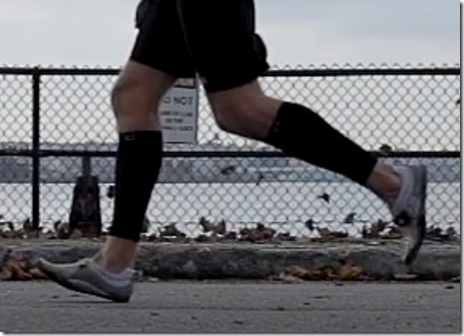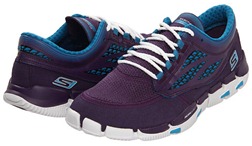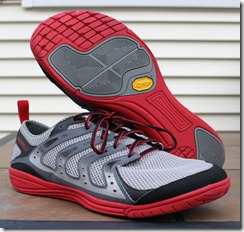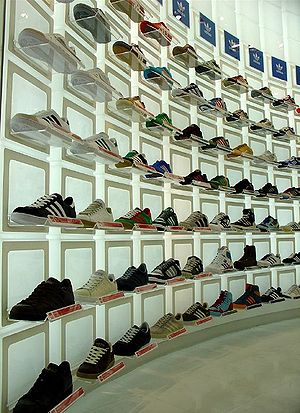 A measurement that has come to dominate a lot of discussion about running shoes these days is heel-toe drop. Simply defined, heel-toe drop (or simply “drop”) is the difference in outsole+midsole+insole height (known as stack height) between the heel and forefoot of the shoe. In other words, it compares the amount of “stuff” between your foot and the ground in the heel and forefoot. Yet another way to look at it is that in a 4mm drop shoe, the heel would sit 4mm above the level of the forefoot.
A measurement that has come to dominate a lot of discussion about running shoes these days is heel-toe drop. Simply defined, heel-toe drop (or simply “drop”) is the difference in outsole+midsole+insole height (known as stack height) between the heel and forefoot of the shoe. In other words, it compares the amount of “stuff” between your foot and the ground in the heel and forefoot. Yet another way to look at it is that in a 4mm drop shoe, the heel would sit 4mm above the level of the forefoot.
Several weeks ago my friend Kurt, who is part of the design team for the Go series at Skechers, asked me a question that got me thinking. He asked if I though that a cushioned zero drop shoe could actually be functionally a negative drop shoe for a heel striker (i.e., heel thinner than the forefoot in this case).
The thinking here is that a heel striker lands on the heel first and compresses it (making it thinner), then rolls forward onto an uncompressed forefoot (which is thicker) – watch this pressure tracing of a heel strike from Daniel Lieberman’s lab to get an idea of how things changes as the foot rolls forward. This thinking seems logical, and is of interest because it could have the consequence of increasing work on the calf and Achilles tendon.
You might say that people shouldn’t be heel striking in zero drop shoes. The reality, however, is that a lot of people do. I have plenty of video of people heel striking even in Vibram Fivefingers, which have very little cushion at all (see below).

Now, suppose someone does adopt a forefoot strike in a cushioned zero drop shoe – here’s another pressure tracing showing a forefoot strike from Daniel Lieberman’s lab. This runner would initially compress the forefoot, then settle briefly back a bit onto an uncompressed heel, and finally roll back forward. Functionally, this zero drop shoe might be behaving a bit like one with a small heel lift.
Following both of these previous examples, a midfoot striker (here’s the midfoot strike pressure tracing) who lands in a cushioned zero drop shoe contacts along roughly the entire lateral margin of the foot/shoe, and thus might compress both heel and forefoot simultaneously. In this case, the shoe functionally behaves like a zero drop shoe.
The above suggests to me is that in a cushioned shoe, functional drop may vary somewhat with foot strike type. Furthermore, this variation will likely be exaggerated as stack height and cushioning softness increase (with an extreme example being the Hokas at the top of this post – they probably behave functionally as a zero or negative drop shoe for a heel striker since they are soft and low-drop to begin with). The more squish on initial contact, the less precise the static drop data will be for a heel or forefoot striker. In contrast, if you run in a shoe with no (or very little) cushion like the Inov8 Bare-X 180, Altra Samson, or a huarache sandal the shoe will behave the same way no matter which way you run since there is very little material to compress.
I wrote this post because I’ve noticed that heel-toe-drop is not a perfect determinant for whether or not I will like running in a given shoe. For example, one of my favorite shoes right now is the adidas Gazelle, which at 6mm drop has a higher differential than most other shoes I run in. However, because it has a firm forefoot with quite a bit of outsole rubber, it actually doesn’t feel a whole lot different on the run than the softer, zero drop Saucony Hattori LC.
I can tolerate a bit higher drop in a shoe if the sole is on the soft side since I’m less likely to forefoot strike in it, and the heel will compress a bit if I land slightly back toward that end. I’m not a big fan of extremely firm shoes unless they have a low stack height. It also might explain why it’s a lot harder on the calves to run with a forefoot strike in a shoe that is zero drop with no cushion since it forces the calf to work through its full range of motion – I like barefoot-style shoes for shorter runs, but don’t use them for runs much longer than about 5 miles for this reason. Conversely, I can run in zero drop, cushioned for long distances without issue.
I guess the point is that the way a running shoe will work for a given person depends on a lot more than just one single factor. Choosing a shoe because it has a medial post, or a certain cushioning technology, or now because it has a particular heel-toe-drop oversimplifies things, and a lot of considerations need to be made when looking for the right shoe for you. Drop is important, and I do feel like it affects how my feet and legs behave when I run, but interpreting the significance of a given drop number probably also requires thinking about things like foot strike type, stack height, and cushioning firmness. As always, things may be more complex than they seem!



















Shouldn’t you want your calf to go through the entire range of motion?
If you are zero drop all the time, sure. Most people aren’t, so it can be tough doing it on the run. I find that if I want to run long distances regularly in barefoot-style shoes I can, but I have to be consistent about it.
—-
Pete Larson’s Web Links:
My book: Tread Lightly – link to ow.ly
Blog: https://runblogger.com
Twitter: link to twitter.com
Facebook: link to facebook.com…
I was able to complete a 27 mile street run in preparation for a 50k in Go Bionics with only moderate lower leg discomfort (hey, it was 27 miles). I think my legs would have fared much worse with a less cushioned shoe like the Altra Instinct or the New Balance Minimus. The actual 50k was run on trails where I wore Hoka Bondi Bs (4mm drop), and again these were lower leg sparing. There definitely seems to be more going on than just the stack height and drop can account for.
I agree. Even though all are zero drop, I could run a marathon in the Bionics, probably not in Vibrams or the Altra Samson without some serious effort to run a lot in them over a period of months.
Sent from my iPad
Do you think those questions lead to shoes that may have different cushioning densities from heal to toe instead of medial to lateral so the compression rates effectively match even though the loading rates are different in the different areas? Effectively changing the selection paradigm based on foot strike instead of pronation. Or do you think there is still room in the paradigm for pronation?
I know I’ve read a blog regarding how muscles activate through the gait cycle, and how it changes with or without shoes, but wanted to get your opinion.
I think there is room to consider pronation still, but just don’t think it should be the only or even primary thing to consider. Varying density longitudinally is an interesting idea, not sure if anyone has tried it. Historically forefoot strikers have just kind of been ignored because they were viewed as atypical. Newtons maybe come closest to doing this with their forefoot lugs and firm heel.
Sent from my iPad
Thanks for the post. I’m really wondering what the factors are to spec the right shoe for the right person for the right distance for the right pace. I (6’2″ 180lb high/stiff arch, low 40 10K) have been running injury free on Kinvara until I upped the pace about a month ago. Wammo! Achillies tendon inflammation at the back of the heal. The prior two years I was on Saucony Hurricane 10’s and was injury free at all paces/distances. I tried the latest Hurrcianes and found them “clunky” compared to the Kinvaras.
There’s a whole bunch of info on the ‘net and I’m not sure which shoe to go with next, but it will probably have more drop. Mizuno Precisions maybe?
As always, stretching, core work, recovery etc are among other factors.
You could try a lightweight 8mm shoe like the Mizuno Ronin or Nike Free Run.
Sent from my iPad
Thanks for the suggestions Pete … After reading throught his post and comments link to runblogger.com… I’m thinking I may have to go with even more heal lift & cushioning to stay on the safe side. A visit to a sports podiatrist is in order as well.
A lifetime of running in cushioned full heal lift shoes may be making it impossible for me to fully transition to something lower slung.
I would warn that there are other factors besides heel lift that could play a role, especially if the pain is at the insertion (eg, a hard heel counter). If heel lift resolves the pain, go for it, but if not, consider other factors as well.
Do I need to “transition” from a 12mm drop to a 4 mm drop shoe? Or can I just go “cold turkey”?
(Adidas Boston to Brooks Pureflow)
Varies from person to person. Your calves will probably be sore after the first few runs so I would at least mix them in with your current shoe for a few weeks. Then just listen to your body and go by feel – if you need to ease off you can use your 12mm shoes. Nothing wrong with mixing up shoe use.
Sent from my iPad
Thank you both very much!
It would be wise to phase in a new shoe and phase out an old shoe, no matter what change in shoe you are making. Generally, week 1 easy runs, week 2 moderate runs, week 3 long runs. Week 4, you should be good to go. Even if just changing brands or models, regardless of drop, cold turkey should never be eaten!
“I guess the point is that the way a running shoe will work for a given person depends on a lot more than just one single factor. ” Very true.
My conclusion from your discussion is that the stack height and more mm of cushioning in, for example, the Newton Distance Racers (a low 2 mm drop) makes them less “barefoot” style (and more forgiving) than, for example, the Hagios (a higher 6 mm drop) with lower stack height.
But how about the factor speed? Do you think the factors you are discussing (density in cushioning, stack height, drop) has bigger impact on the workload on your muscles (calfs) than actual running speed? Im rotating Hagios and the Distance Racers and I percive both as “firm” (or at least not soft). When running slow or long distance in my Hagios (6 mm drop) and the Distance Racers (2 mm drop) I don’t feel much of a difference in soreness. But when running fast, the calfs get far more sore in the Hagios than In the Newtons.
For me, speed has more impact on sore calfs and hamstrings (and a potential injury) than any factor.
I wonder if the forefoot lugs on the Newtons assist in the cushioning when running fast, especially if you get up on the forefoot?
Sent from my iPad
Hi Pete,
I’m a firm believer in that the dynamics of how the shoe deforms during the whole stance is critical to how your foot, legs and rest of body are loaded up. It’s not just an issue of the shoe controlling the loads, but the runner will be automatically adjusting in response to the loads felt at the shoe so it’s a complex relationship and as the bio-mechanics and habits change between runners then the response seen is likely to be rather personal.
As the whole terrain/shoe/runner system is a complex relationship I find it useful to consider the model of shoe becoming part of the “effective” terrain with the conceptual runner barefoot landing on this “effective” terrain. I find this model helpful in working out the job the brain must be doing to work what it thinks of the terrain it’s running and how to respond.
For instance a high heel drop would mean that you are running into sloping ground on landing, and with the heel area softer so will deform more levelling the slope of the foot sees. With this we’d expect an extra eccentric loading of the Achilles and calf over what you’d see with a firm sole. A heel strike will exacerbate just how the heel will sink in and level the shoe.
With a soft high heel drop shoe you have this odd “effective” terrain to work out – every single stride your heel sinks in and bounces back as you move from landing to late stance but the forefoot is on relatively firm ground.
Also If one thinks about medial posts then here we have the oddity of soft effective ground on one side or the foot and hard on the other. What the brain going to make of that? What adjustments might we make on how we load the foot landing, on stance and toe off?
While you are thinking of effect of cushioning and slope work dynamically on stance it’s also useful to consider the effect of the toe spring. Toe spring means that our toes are kept largely off the ground due to an “effective” whole in the terrain below the toes. As we move from mid stance to toe off our toes fall into an effective hole. This changes the amount of bend at the toes on at toe off, the loading on the arch/plantar fascia and the potentially the effective height of the foot and the rest of the body as well if the toe spring goes back underneath the metatarsal heads. For shoes with rockered soles you’ll loose a little bit of height on toe off as your forefoot falls into an effective hole in the ground.
Finally have a think about the whole stride and the effect of this oddly shaped and cushioned “effective” terrain that are shoes are creating for us. An elevated heel means that the foot will have to be landing on effectively higher ground, and a big toe spring/rocker will mean on toe off we are pushing off from lower ground – together this means we are running a little uphill when airborne (our feet have to be raised a little) but downhill slope on stance.
—
Personally I like to get good feedback about what I’m landing on as I can and not have it clouded by shoe “technology”. An even density of sole with no lateral or longitudinal slope is idea. I’m OK with a bit of softness in the sole, especially on trails as it means that I’m effectively running on slightly spongy stones and roots. Too much elevation and softness isn’t good though – it feels unstable.
These days find running in soles with no cushioning (like my Vivobarefoot Neo Trails) does not cause calf discomfort whether on trail or road. I do find it takes me couple of minutes to adjust into lack of cushioning if I have been running in predominately more cushioned shoes for a while. I don’t know how much this is down to adjusting my gait or whether it’s just my brain adjusting to a new normal w.r.t how much feedback I get on landing. For the last six months I’ve run around 1/3rd of my miles in Neo Trails so I’m guessing I’m now pretty well adapted to running without cushioning.
Thanks for the thoughtful comment as always Robert! It is amazing how the brain must react to all of the variations we throw at it – I wonder if that’s why you have to be consistent about running in uncushioned shoes to maintain adaptation to them, the brain gets confused by all of the other stuff we wear?
Sent from my iPad
It truly is amazing just how crazy human footwear can be and still not totally cripple our ability to walk and run. Most extreme has to be women’ high heels shoes that have ladies hobbling around on there toes. For some bizaare reason this is seen as elegant??! We are definitely as amazing as we are crazy :-)
I suspect the emergence of oddities like the Hoka come from notion that you need more cushioning the further you run. Now if you have a runner who trains in cushioned shoes for all their moderate distance runs, they naturally crave even more cushioning when they up the distances such as when running ultras. So Hoka’s and other maximal footwear may be as much a symptom of a training problem as much as actual solution.
Personally I try to wear relatively minimal shoes with an anatomical
last all the time. Originally this was to try and make sure that I
built up the foot strength and proprioception to aid my running in
minimal shoes, but these days I find it unpleasant to wear any
restrictive, stiff or overly supportive footwear.
For the ultra’s I’ve run this year I have worn the relatively cushioned Roclite 295’s, so I too have upped the cushioning level as I’ve upped the distances but as I start from a more minimal base one doesn’t have to upgrade the cushioning too far. The choice of Roclite’s is really about cushioning though, rather until the Trailroc’s I’ve just bought I couldn’t find a trail shoe that was wide and protective enough for such long excursions.
i’m not sure you can consider a forefoot strike with a zero drop shoe making it act as a postitive drop shoe in any way. reason is, the bigger the heel, the more the forefoot striker is encline to hit the heel first. which would clearly not happen with a zero drop shoe and a real forefoot striker. I’m guessing (though not an expert) that the stress on the heel, achilles and perioste in general is totally different and depends on the angle of the ankle when the pressure is applied…?
I think the stress applied definitely varies with ankle angle on contact. For example, anterior compartment syndrome and anterior shin splints seem to respond well to foot strike modification away from a pronounced heel strike. But, the stress isn’t gone, it just gets shifted more to the foot and posterior compartment. But, if a person can tolerate that new stress better it’s a worthwhile approach.
Sent from my iPad
Good post. Another thing to consider is shoe wear. Take something like the Brooks T7. The T7 has a 12mm drop, a durable carbon rubber heel, and a blown foam forefoot. I’m a light heelstriker in practice, but tend to get very little heel wear and all forefoot wear (even on shoes with more consistent soles). By the time I’m done with a pair of T7s, I wouldn’t be surprised if the drop is up to 14mm or so due to wear.
Just to clarify, when I say wear, I’m talking about both outsole being left on the ground and midsole being compressed.
What if there would be a zero drop shoe, but with different cushions (firmer in the heel and softer in the forefoot)?
I am meeting more and more runners with Achilles tendonitis. They are
running in traditional 12mm drop very cushioned shoes. I too had that
problem for a year and made my change over to 4mm drop shoes and haven’t
looked back.
However, are there any real scientific studies done showing more minimal
footwear lowers the incidence of Achilles tendonitis?
Not that I am aware of, minimal is still fairly new when it comes to linking things to specific injury rates.
—-
Pete Larson’s Web Links:
My book: Tread Lightly – link to ow.ly
Blog: https://runblogger.com
Twitter: link to twitter.com
Facebook: link to facebook.com…